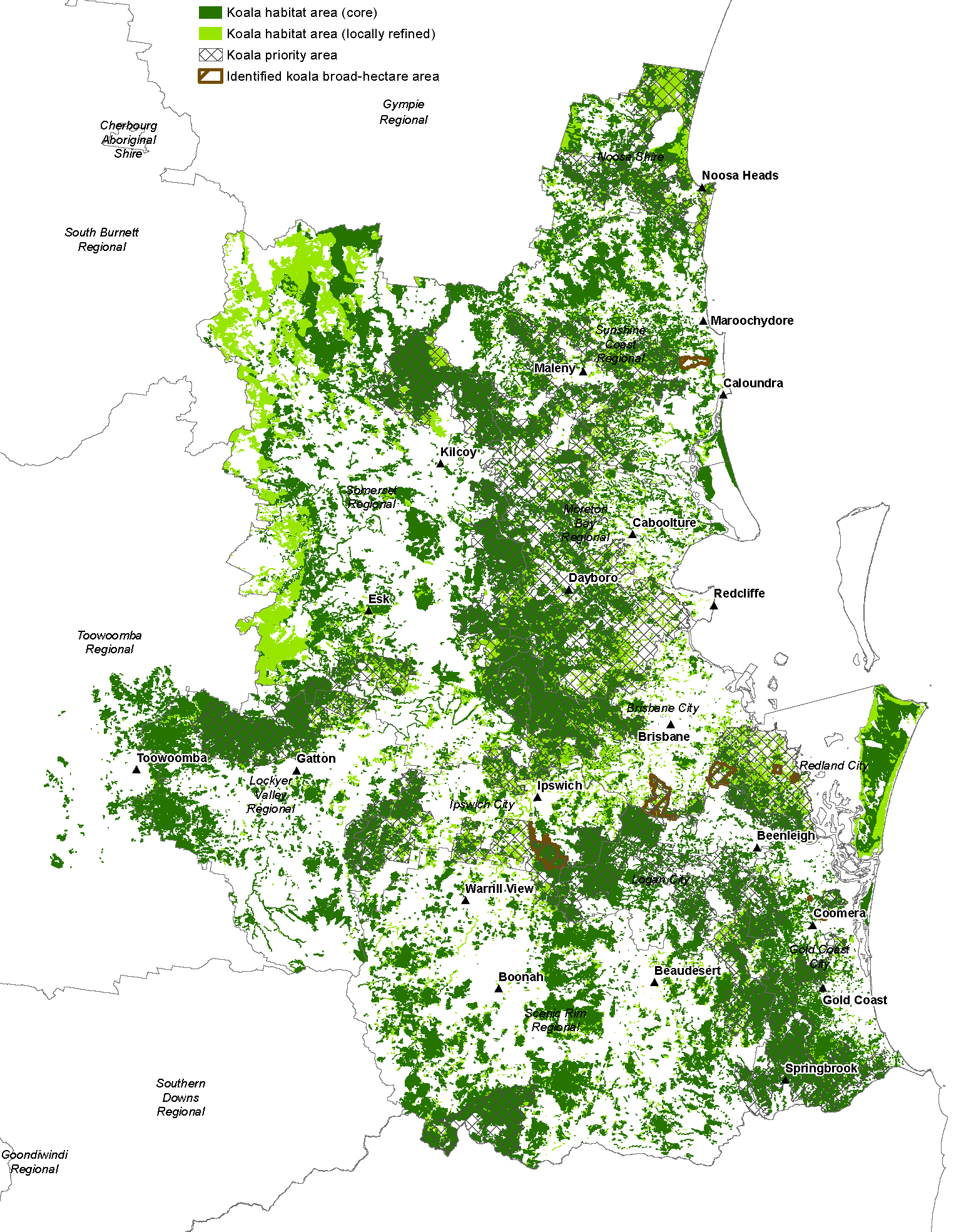Download this page as PDF.
 Key points
Key points
- Koala habitat is an area of vegetation where koalas live that includes a koala habitat tree (for feeding and shelter), or areas of koala habitat trees suitable for koalas, including cleared areas used by koalas to cross between these areas.
- South-East Queensland Local Governments added areas to ‘koala habitat protection areas’ on 29 August 2020. Koala habitat maps are updated annually to include new, amended or revoked areas.
- Over 716,000ha is regulated for koala conservation in SEQ.
- Check your property vegetation map to see if this affects you.
Koalas are listed as vulnerable under state and federal legislation. On 7 February 2020, the Queensland Government Department of Environment and Science DES strengthened regulations for koala habitat areas (KHA) in south east Queensland (SEQ). KHA are assessed separately to vegetation management and essential habitat.
In August 2020, Local Governments included “Locally Refined Koala Habitat Areas” LRKHA into Queensland’s koala habitat maps. Local and state governments will transition LRKHA into core koala habitat areas KHA over a two-year period. LRKHA are regulated by local government. The 8 September 2020 map update shows 24,000 LRKHA converted into Core Koala Habitat Areas (KHA) and 25,600ha removed from LRKHA.
Apart from LRKHA's, there are no other current changes to KHA's released by Queensland Government in February 2020. This includes Koala Priority Areas (KPAs), KHAs and Koala Habitat Restoration Areas (KHRA). Future annual updates will also include koala sightings by community residents.
All clearing is prohibited in KPAs. This includes Locally Refined Koala Habitat Areas (LRKHA) and Category X areas within a KPA. Clearing can still occur in existing PMAV areas, if locked in prior to 7 February 2020.
Clearing exemptions within a KHA for Category B, C and R regulated vegetation include a one-off development footprint up to 500m2, firebreaks and fire management lines, removal of dangerous trees, clearing for a fence or road, native forest practice and essential management. Full list of exemptions available in Schedule 24 of the Planning Regulation 2017.
If you are using one of the Accepted Development Vegetation Clearing Codes (ADVCC), check the code for the koala framework requirements.
If a KHA or LRKHA is mapped incorrectly, you can request to amend or revoke the area. For example, if the mapped area does not contain native woody vegetation or the type of vegetation is not a koala habitat regional ecosystem.

Koala priority and habitat areas in south east Queensland
Different protection requirements for impacts on koala habitat apply to these areas. Maps and more details are available from environment.des.qld.gov.au and this factsheet (PDF)
AgForce provides members with an annual GeoPDF property map or you can request a free online property map of koala habitat areas from this Qld Govt webpage.
Koala habitat mapping is also available via the Queensland Globe.
- Qld Government assesses vegetation clearing in koala habitat areas (green areas on the map).
- Local government will assess applications not involving clearing within the Koala Priority Areas (in accordance with Schedule 11 of the Planning Regulation 2017).
- Core koala habitat areas (dark green on the map) are best quality habitats, based on modelled climate, vegetation and koala sighting records.
- The Chief Executive from the Dept of Environment and Science determines koala habitat areas.
- Non-statutory restoration areas identify “koala habitat restoration areas” of high conservation value and low threats (orange areas on a koala habitat map).
Koala Habitat Tree is a koala feeding tree (Genus Corymbia, Melaleuca, Lophostemon or Eucalyptus) or shelter tree (Genus Angophora or other genera)
Regulatory requirements for clearing native vegetation in KPA and KHA
Clearing of native woody vegetation is prohibited in Koala Priority Areas KPA (criss-cross brown hatches on the Koala Conservation Plan Map. Exemptions include assessable development or reconfiguring a lot within koala broad-hectare areas, exempted developments including State forests/timber reserves or developments approved prior to 7 February 2020.
Clearing in Koala Habitat Areas KHA outside the KPA areas is Assessable Development, unless an exempted activity, extractive industry-approved prior to 7 Feb 2020 or an approved activity within the koala broad-hectare areas.
Exemptions for clearing koala habitat are listed in Schedule 24 of the Planning Regulation 2017 . These include development approvals and clearing Category X on a PMAV made before 7 February 2020. Certain clearing activities are exempt without the need to notify or seek approval under the vegetation management framework.
Low-risk clearing that is not authorised by exempt clearing works in Schedule 24, requires prior notification under the Accepted development vegetation clearing codes ADVCC and the clearing activity must comply with practices in the relevant code. ADVCC’s include clearing for infrastructure, native forest practice, weed control, necessary environmental clearing, extractive industries, and managing regrowth.
For KHAs
Sequential clearing of koala habitat trees in SEQ Koala District A or B (as per Nature Conservation (Koala) Conservation Plan 2017).
- Clear in stages, with at least a 12-hour gap in clearing activity (If 6ha or less, only clear up to 50 per cent. If more than 6ha area, up to 3ha or 3 per cent of the area).
- Provide appropriate habitat links during clearing.
- Do not clear a habitat tree if a koala is present.
- A skilled koala spotter is required if the habitat tree diameter is greater than 10cm at 1.3m above the ground.
Changes to Regrowth Code
- New notification and clearing limitations (10ha per lot, renotify and self-audit).
- No clearing for agriculture.
- No clearing which will cause a disconnection between two or more environmentally sensitive areas 100m in width.
Changes to Weeds Code
- New notification and clearing limitations (10ha per lot, renotify and self-audit).
- Weed management methods need to be necessary and reasonable.
- Can only clear immature koala habitat trees, if the area is managed to support the natural regeneration of koala habitat trees.
Changes to Necessary Environmental Clearing Code
- Allows clearing of mature trees and koala habitat trees if retention prevents flood preparation works.
- Avoid or minimise clearing in koala habitat areas for channel diversion, or not to exceed the 10m width limit and a koala offset is secured.
- Areas to be managed to support the natural regeneration of koala habitat trees.
- Avoid or minimise clearing in essential habitat. Clearing width limits are 5 metres (for a lot less than 5ha) or 10 metres (for a lot greater than 5ha) for linear infrastructure (fence, road, track) and development areas up to 500m2 in Category B, C and R, unless a koala offset is secured.
- Cleared area for infrastructure, airstrip and extractive industry up to 500 m2 in Category B or C areas.
- Avoid clearing in Category B for an extractive industry. Koala offset may be required for Cat C, R or X.
- Diversion of a watercourse or drainage feature in Category C up to 500m2.
For larger scale clearing activities, development approval (DA) under the Planning Act 2017 is required. A development application must demonstrate how koala habitat and koala safe movement will be maintained. The Assessment Benchmarks in relation to Koala Habitat in SE Qld and State Code 25: Development in SE Qld koala habitat areas provide a range of ‘acceptable solutions’ to ‘performance outcomes’ to ensure clearing applications minimise the impact on koala habitat.
More information
Queensland Department of Environment and Science - Phone 13 QGOV (13 74 68), or email SEQKoalaStrategy@des.qld.gov.au

